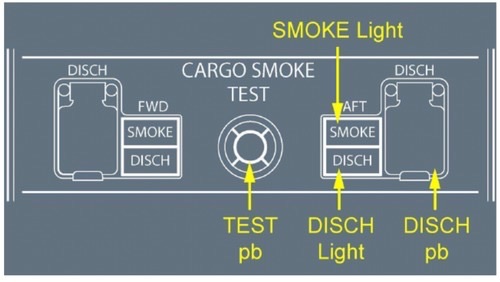The Airbus A320’s fire protection system is a meticulously designed safety feature that protects both the crew and the aircraft from potential fire hazards in critical areas such as the engines, auxiliary power unit (APU), and cargo compartments. Based on the Airbus A320 Flight Crew Operating Manual (FCOM), the system consists of several layers of detection and suppression mechanisms tailored to monitor, alert, and suppress fires in different sections of the aircraft.

Engine Fire Protection
Each engine is equipped with a dedicated fire detection and extinguishing system. The primary components include:
- Fire Detection Loops: The A320 uses dual-loop fire detectors around each engine. These loops, known as Loop A and Loop B, work to prevent false alarms by only triggering a fire warning if both loops detect excessive heat or fire simultaneously. In cases where one loop fails, the system automatically switches to single-loop operation, maintaining detection capability.
- Fire Extinguishing System: Each engine is equipped with two fire extinguisher bottles containing halon gas, an effective fire suppressant. When an engine fire is detected, the flight crew can manually discharge these bottles using dedicated fire push buttons in the cockpit. Each extinguisher is individually activated, allowing the crew to manage fire suppression based on the severity and persistence of the fire.
- Fire Shutoff Valve: Activating the engine fire push button closes the fuel, hydraulic, and pneumatic bleed-air valves to the affected engine. This action limits the fuel supply and airflow, further mitigating the fire risk and isolating the affected engine.

APU Fire Protection
The APU (Auxiliary Power Unit), which provides electrical power and bleed air on the ground and acts as a backup power source in flight, has its own fire detection and suppression system. Key components include:
- Fire Detection Loops: Similar to the engines, the APU is monitored by dual-loop fire detection. Both loops must detect a fire condition to trigger a warning in normal operations. In the event that one loop fails, the system automatically switches to single-loop monitoring, ensuring continuous fire detection.
- Automatic and Manual Extinguishing: In case of an APU fire on the ground, the system is designed to discharge the fire bottle and shut down the APU automatically. However, during flight, APU fire extinguisher activation requires manual intervention by the flight crew. The APU fire extinguishing system also uses halon gas as a suppressant, effective in confined areas.
- APU Shutoff Mechanism: When an APU fire is detected, the system initiates an automatic shutdown of the APU, cutting off fuel and airflow to prevent the spread of the fire.

Cargo Compartment Fire Protection
The A320 cargo compartments are particularly vulnerable areas due to the variety of materials and goods stored there. The system includes smoke detection and fire suppression in both forward and aft cargo holds:
- Smoke Detectors: The forward and aft cargo compartments are equipped with smoke detectors that operate on a dual-loop basis. When both loops detect smoke, a cargo smoke warning is issued to the cockpit. If only one loop detects smoke, the system provides a fault alert without triggering a warning, reducing the chance of false alarms.
Lavatory Fire Protection
The A320 lavatories have an automatic fire detection and extinguishing system as a precaution against potential fires due to discarded smoking materials or other heat sources:
–Smoke Detectors: Each lavatory is fitted with a smoke detector, which provides an alert to the cockpit and cabin crew if smoke is detected. - Automatic Fire Extinguishers: Lavatories are equipped with small, self-activating extinguishers in the waste bins. These extinguishers deploy automatically if the temperature within the bin reaches a preset threshold, suppressing any fire at the source.
Avionics Compartment Fire Protection
The avionics compartment, which houses crucial electronic and control systems, is equipped with a ventilation smoke detection system:
-Smoke Detection: The avionics compartment is monitored for smoke as part of the aircraft’s environmental control system. If smoke is detected, an alert is sent to the cockpit. While there is no dedicated fire extinguishing system for the avionics compartment, crew procedures involve isolating the compartment and shutting off any relevant systems if smoke is detected.
Flight Deck and Cockpit Fire Protection
In the cockpit, fire suppression is manual, with handheld fire extinguishers provided for quick access by the flight crew in case of an internal fire.
-Fire Extinguishers: The cockpit is equipped with portable halon fire extinguishers that can be used to combat localized fires. Additionally, oxygen masks are available for the flight crew to use during smoke or fire incidents, ensuring their ability to breathe in a smoke-filled environment.

Fire Warning and Indication System
All fire detection systems on the A320 are integrated into a centralized warning and indication system. Fire warnings are displayed on the Electronic Centralized Aircraft Monitor (ECAM) and accompanied by auditory warnings, alerting the crew to the exact location and nature of the fire. This rapid notification system allows the flight crew to respond immediately using the aircraft’s fire procedures.
Conclusion
The Airbus A320’s fire protection system exemplifies redundancy, automation, and manual control, ensuring comprehensive fire detection and suppression across key areas of the aircraft. This multi-layered approach, designed to address both immediate and sustained fire suppression needs, highlights Airbus’s commitment to passenger and crew safety.
For all aviation-related guidance (DGCA ground classes, pilot training, cabin crew training)
Contact us https://contrail.in/
phone numbers +91 78457 69399


